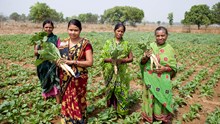
In India's rural and semi-arid tracts, goats are more than just an animal. It's a friend, a guardian of livelihood, and a symbol of hope. Farmers with small landholdings or no land at all have traditionally reared goats because of their ability to thrive in rough terrains, feed on shrubs, and live in simple shelters. During dry fields and scarce rains, goats manage to survive. They need very little to remain healthy, and in exchange, they provide milk, meat, fiber, and even skin that can be sold.
In most villages, goats graze freely on bushes, weeds, and agricultural wastes freely. Goats are not merely animals; they are a means of food, income, and security for millions of families. Thus, goat rearing is made accessible to individuals who cannot purchase or cultivate special animal feeds. Indeed, goats can utilize land and resources which would otherwise go to waste.
Why Goat Farming is a Good Idea
Goats are a boon in more ways than one. They are gentle and easy to handle, even for women and senior citizens. A shed constructed of locally available materials such as bamboo, palm leaves, or thatch is sufficient to accommodate a small flock. Unlike buffaloes and cows, goats don't need elaborate structures or costly feed.
They grow rapidly and reproduce fast. A female goat becomes ready for breeding by the time she is 10 to 12 months old. Most goats give birth to twins, and sometimes even triplets. So, within a short period of time, a farmer's herd can double and fetch more revenue.
Goat milk is very nutritious and digestible compared to cow milk. It's particularly beneficial for children, the elderly, and even patients. Those who are allergic to cow milk tend to fare well with goat milk. Chevon, or goat meat, is also lean and healthy, and there is a high demand for it in rural and urban markets.
Selecting the Right Goat
Choosing the appropriate breed is essential if you wish to obtain good milk or meat. Malabari, Osmanabadi, Jamunapari, Beetal, and Barbari are a few of the renowned Indian breeds. Malabari goats are typical in Kerala and can be used for milk and meat. Osmanabadi goats, which are typical in Maharashtra, are hardy and can thrive in arid regions.
Uttar Pradesh's Jamunapari goats are large in size and have high milk production. Beetal goats, found in Punjab, are similar to Jamunapari and are excellent for milk and meat. Barbari goats, although small in size, are fast-growing and suitable for intensive farming.
When purchasing a goat, farmers should inspect the weight and condition of the animal. A one-year-old female goat should weigh approximately 20 kg. It is advisable to select goats whose mothers had high milk production and healthy offspring. A good udder, bright eyes, and smooth coat are indications of a good milch goat.

Goat Farming in India – Abundance of Breeds
India is rich in diverse goat breeds for various climates and areas. In the Himalayan tracts of Himachal Pradesh and Kashmir, breeds such as Gaddi and Chegu are not only kept for meat but also for their good wool or pashmina. In Rajasthan and Madhya Pradesh, breeds such as Marwari and Mehsana are common. In the Eastern states such as West Bengal and Assam, strong and compact goats such as the Bengal breed do well in moist, hilly areas. These goats are famous for their fine flesh and delicious meat.
Certain farmers also try experimenting with foreign breeds such as Sannen, Alpine, or Toggenberg, which produce more milk but may need better care and feeding. They are usually crossed with indigenous ones to enhance the yield of milk while retaining the animal's hardiness.
More Than Just Farming – A Way to Empower Lives
Goat keeping is not simply an enterprise, it is a way to uplift rural livelihoods. It provides employment for the entire household. Women can milk the goats and take care of the kids (young goats), whereas men do the grazing and take them to market. Young children and Elderly citizens also lend a hand in keeping eyes on goats throughout the day.
Some enterprising farmers are also starting small-scale businesses using goat milk and meat. Goat milk soaps, cheese, and even fiber products are slowly gaining popularity. The skin of Bengal goats is in high demand for making shoes and handbags. In this way, goats help build cottage industries and increase rural employment.
Goat farming is a simple and profitable venture that is perfectly suited for Indian conditions. It offers an avenue to food security and economic freedom for marginal and small farms. It can become a consistent income source with proper care, strategic selection of breeds, and some preparation. Goats remain a quiet savior in a country like India where rural livelihoods need serious assistance, proving the strength of little creatures.
















